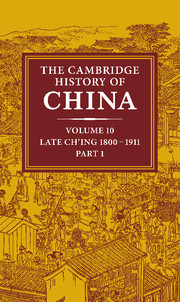Book contents
- Frontmatter
- 1 Introduction: the old order
- 2 Ch'ing Inner Asia c. 1800
- 3 Dynastic decline and the roots of rebellion
- 4 The Canton trade and the Opium War
- 5 The creation of the treaty system
- 6 The Taiping Rebellion
- 7 Sino-Russian relations, 1800–62
- 8 The heyday of the Ch'ing order in Mongolia, Sinkiang and Tibet
- 9 The Ch'ing Restoration
- 10 Self-strengthening: the pursuit of Western technology
- 11 Christian missions and their impact to 1900
- Bibliographical essays
- Bibliography
- Genealogical chart
- Glossary
- Index
- References
7 - Sino-Russian relations, 1800–62
Published online by Cambridge University Press: 28 March 2008
- Frontmatter
- 1 Introduction: the old order
- 2 Ch'ing Inner Asia c. 1800
- 3 Dynastic decline and the roots of rebellion
- 4 The Canton trade and the Opium War
- 5 The creation of the treaty system
- 6 The Taiping Rebellion
- 7 Sino-Russian relations, 1800–62
- 8 The heyday of the Ch'ing order in Mongolia, Sinkiang and Tibet
- 9 The Ch'ing Restoration
- 10 Self-strengthening: the pursuit of Western technology
- 11 Christian missions and their impact to 1900
- Bibliographical essays
- Bibliography
- Genealogical chart
- Glossary
- Index
- References
Summary
FAILED EFFORTS TO EXPAND COMMERCE
As the only European power active in Inner Asia, Russia held a special status in the Manchus' firmament. The Treaty of Nerchinsk in 1689 had loosely defined a border and had established the principle of equality between the Ch'ing and Muscovite empires. Three preliminary agreements and the Treaty of Kiakhta in 1727 had extended the boundary line farther west and appointed two places for Russian trade: Kiakhta on the northern frontier of Mongolia, and Tsurukhaitu (Curhaitu) on the Manchurian frontier near Nerchinsk. At both these places Ch'ing and Russian merchants could carry on duty-free trade, but Tsurukhaitu failed to develop as a commercial centre, so that virtually all the legal private commerce came to take place at Kiakhta. In short from the 1720s Russia possessed a market for Sino-Russian private trade in which both sides communicated on terms of equality. It would take Britain and the other Western powers until the 1840s to obtain such conditions on the China coast.
In addition to the Kiakhta trade, Russia could send a caravan to Peking every three years, on the understanding that the caravan leader would perform the Chinese tributary ceremonies, and Russia was allowed to maintain an ecclesiastical mission in Peking. Apart from these concessions, the Ch'ing excluded all Russians from the Middle Kingdom.
Russia's official caravans were not profitable enough. Smuggled furs glutted the market in Peking. Russian exports secretly bypassed Kiakhta and found their way to Urga in Mongolia and to Naun in Manchuria, while Chinese goods bypassed Kiakhta on their way to Irkutsk.
- Type
- Chapter
- Information
- The Cambridge History of China , pp. 318 - 350Publisher: Cambridge University PressPrint publication year: 1978
References
- 4
- Cited by

